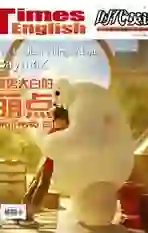Unit 8 How do you make a banana milk shake?
2015-04-29
重点词汇
1.shake n. v. 摇动;抖动
Give it a good shake.
用力摇一下它。
He was shaking with anger.
他气得浑身发抖。
shake sb’s hand/shake hands with sb/shake sb by the hand 与某人握手
A stranger walked up to me and shook my hand.
有个陌生人向我走来跟我握手。
2.pour v. 倒出;倾倒
(1) pour作及物动词时,其后接宾语或双宾语。
Please pour me a glass of water.
请给我倒杯水。
(2) pour...into...表示“把……倒进……里”,常指液体,相当于put...into...。
She poured some orange juice into my glass.
她往我的杯子里倒了些橙汁。
(1) pour out 倒出
(2) pour down 倾泻;奔流而下
3.add v. 增加;添加
add可作及物动词和不及物动词,意为“增加;添加”。
常用搭配:
(1) add...to/into/in 把……加到……中
(2) add to 增添,添加
She added sugar to her tea.
她在茶里加了糖。
Her illness added to the family’s troubles.
她的病给家人添了麻烦。
add up 把……加起来
Please add all the numbers up.
请把所有的数加起来。
4.piece n. 片;块;段
一般说来,不可数名词不可以用数目来计数,若要计数,则要借助单位词,其中用于对不可数名词计数的最常用的单位词就是piece。
a piece of paper 一张纸 a piece of advice 一条建议
a piece of news 一条消息 a piece of chalk 一支粉笔
a piece of bread 一片面包 a piece of music 一首音乐
a piece of wood 一块木头 a piece of furniture 一件家具
注意:
不要按汉语习惯在不该用单位词的地方错用单位词,如“一张邮票”只能说 a stamp,而不能说 a piece of stamp。
5.celebrate v. 庆祝;庆贺
We celebrated the New Year with a dance party.
我们举行舞会庆祝新年。
celebration n. 庆祝活动
6.mix n. 混合配料
v. (使)混合;融合
Alcohol and drugs is a deadly mix.
酒精和毒品混在一块儿,足以令人毙命。
If you mix blue with yellow, you’ll get green.
蓝色和黄色混合在一起就成了绿色。
mix up 混合;混淆
She mixed up flour and water.
她把面粉和水搅匀。
Never mix up these two words.
千万别把这两个词相混淆。
7.fill v. (使)充满;装满
fill可作及物动词和不及物动词。
(1) fill作及物动词时,表示“(使)充满;装满”。
Everything is filled with new life.
万物充满了生气。
Clive filled his pockets with apples.
克莱夫将口袋装满了苹果。
(2) fill作不及物动词时,表示“满,充满”。
Her eyes filled with tears.
她的眼里充满了泪水。
8.cover v. 遮盖;覆盖
n. 覆盖物;盖子
He covered his knees with a blanket.
他用毛毯把膝盖盖住。
He put the cover on his piano.
他给钢琴罩上了琴套。
be covered with 被……盖满;充满着……
The tree is covered with flowers now.
那棵树现在开满了花。
9.serve v. 接待;服务;提供
Four waiters served lunch for us.
有四位服务员招待我们吃午饭。
常用搭配:
serve sth to sb/serve sb sth 拿某物招待某人
Meal can be served to you in your room.
餐点可以送到你的房间。
She served me a cup of coffee.
她给我端来一杯咖啡。
service n. 服务
重点短语
turn on 接通(电流、煤气、水等);打开
Please turn on the TV.
请把电视打开。
反义词组:turn off 关掉,关上
(1) turn up 开大;调高
(2) turn down 关小;调低
I can’t hear the music clearly. Please turn up the radio.
我听不清音乐声,请把收音机的声音调大点。
Would you like to turn down the recorder?
你能把录音机的声音调小一点吗?
即时练习:
1. Please turn ____ the TV. Let’s go to the supermarket to buy something.
A. onB. off
C. downD. up
2. She asked Mary to ____ her a cup of tea.
A. mixB. make
C. addD. pour
3. First put some salt into the water and then ____ .
A. mix them upB. mix up them
C. mix it upD. mix up it
4. I’m so hungry. Please give me ____ to eat.
A. three breadsB. three pieces of bread
C. three piece of breadD. three pieces of breads
5. Will you add more honey ____ the salad?
A. toB. for
C. withD. at
参考答案:
基本语法
一、可数名词和不可数名词
1. 可数名词
可数名词是指能以数目来计算,可以分成个体的人或东西,因此它有复数形式。当它的复数形式在句子中作主语时,句子的谓语也应用复数形式。例如:
Little children are fond of stories.
小孩子们喜欢听故事。
Movie stars are usually popular with young people.
影星们常受到年轻人的欢迎。
它的单数形式前常用不定冠词a/an,当它的单数形式在句子中作主语时,句子的谓语也应用单数形式。例如:
There is an orange on the table.
桌上有一个橘子。
A university is a higher educational institution.
大学是高等教育机构。
2. 不可数名词
不可数名词是指不能以数目来计算,不可以分成个体的概念、状态、品质、感情或表示物质材料的东西。它一般没有复数形式,只有单数形式,它的前面不能用不定冠词a/an,若要表示它的个体意义时,必须与一个名词短语连用,相当于中文里的“数词(+量词)+名词”,其中的量词意义应与具体的名词搭配而定。例如:
a piece of bread(cake,paper,thread(线),furniture(家具),coal(煤),news,advice(建议),information,meat)
它在句子中作主语时,句子的谓语也只用单数形式。例如:
Wealth doesn’t mean happiness.
富有并不意味着幸福。
注意:上面提到的可数名词和不可数名词并不是一成不变的。英文中的很多词都是一词多义,名词也不例外,同是一个词,在一种情况下是可数名词,而在另一种场合却是不可数名词:
可数名词:a tin一只金属罐;a relation一个亲戚;an iron一把熨斗;a democracy一个民主国家;a glass一只玻璃杯;a beauty一个美人;一件美的东西;a wood一片树林;a power一个强国。
不可数名词:tin锡;relation关系;iron铁;democracy民主;glass玻璃;beauty美;wood木头;power权力。
另外,在很多情况下抽象名词可变成可数名词;而可数名词在一定情况下也可以抽象化,变成不可数名词:
Would you like some coffee?(不可数名词)
你想喝点咖啡吗?
Let me have a coffee.(可数名词)
给我一杯咖啡吧。
He got in difficulty again.(不可数名词)
他又有困难了。
They met with many difficulties.(可数名词)
他们遇到很多困难。
二、how many与how much的用法
1. how many表示“多少”,对数量提问,后面接可数名词的复数形式。
There are four people in my family.
→ How many people are there in your family?
你家里有几个人?
We have seven classes every day.
→ How many classes do you have every day?
你们每天上几节课?
2. how much也是表示“多少”,但它对不可数名词进行提问。
There is a little milk in the bottle.
→ How much milk is there in the bottle?
瓶子里有多少牛奶?
注意:how much还可以对价格提问,表示“多少钱”的意思。
How much is the yellow T-shirt?
那件黄色的T恤衫多少钱?
